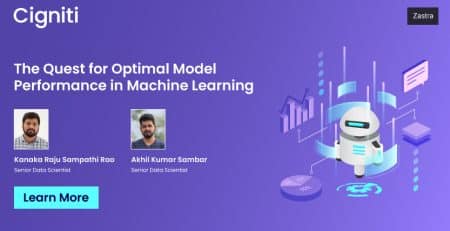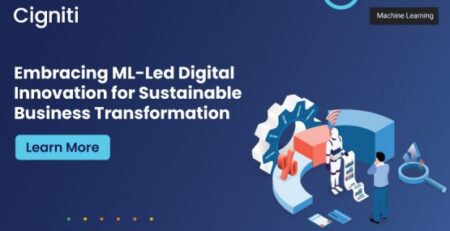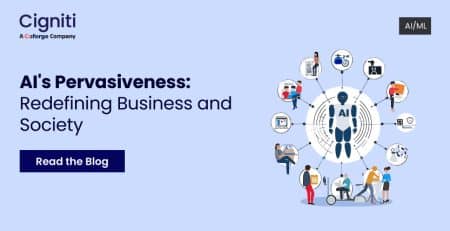Enterprises Need to Deploy, Monitor, and Govern ML Models to Solve Real-World Use Cases
Machine Learning (ML) and Artificial intelligence (AI) are at the center of the hyper-competitive era in which change occurs with new technologies in the span of a single blink of an eye. Modern innovations like AI, predictive analytics, ML, and other digital disruptors are changing how businesses operate and how customers interact with brands in every sector of the economy.
Moments of existential transition are becoming common for organizations. Today, leaders must have the knowledge and capabilities to incorporate AI into their overall company strategy in this era of digital disruption.
The hype about AI from a few years ago is undeniably a reality today, with every business searching for ways to take advantage of the potential long-term advantages. The number of businesses employing the top AI and data scientist teams to support their company performance is expanding daily, regardless of whether you operate a company that focuses on retail, finance, construction, or anything in between.
However, establishing and executing AI/ML models is not simple, and there is a high chance of failure. Certain businesses have improved their bottom line by increasing their investment in AI. To lessen this risk and help businesses flourish, a sound process is required.
Implementing an AI model that is scalable
Implementing enterprise AI requires major businesses, which operate in dynamic business settings, to adapt to such changes. Speed is a crucial competitive advantage in every business. Being the first in the market to adapt might provide a company with an exponential business advantage if it can swiftly transform its model to suit the new business environment.
Businesses now have a bigger hunger for AI, and associated investments are also rising. Organizations will keep looking at AI in the future to improve their decision-making procedures. Techniques and approaches that were previously thought to be too avant-garde to be used will become standard. Faster adoption of these techniques by smart firms will increase competitive distinctiveness and increase their agility and receptivity to ecosystem changes.
“By 2025, 80% of the biggest enterprises on the planet will have taken part in federated ML at least once in order to develop models that are more precise, secure, and environmentally friendly.”
-Gartner
ModelOps – A strategic approach to ML modeling
The startling reality is that 87% of ML models never enter production. In other words, just one out of every 10 workdays for a data scientist truly results in something beneficial for the business. The time it takes to prepare for deployment for those models that do make it to production is at least three months. The additional time and work result in a real operating expense and a longer time to value.
ModelOps is a framework or technique that would minimize human labor and speed up the deployment of ML models is necessary to address this difficulty.
ModelOps is a methodology in AI and Advanced Analytics that promises to transfer models as rapidly as can from the lab to validation, testing, and production while maintaining high-quality results. It allows for the management, scalability, and continuous monitoring of models to identify and address any early indicators of deterioration.
Analytical models are cycled from the data science team to the IT production team using the ModelOps methodology in a regular deployment and upgrade cycle. Only a select few organizations are utilizing this winning component in the fight to realize value from AI models. It enables you to transfer models as rapidly as possible from the lab to validation, testing, and production while maintaining top-notch outcomes.
Adding transparency to AI
All information is controlled, monitored, and auditable thanks to ModelOps. This is crucial for monitoring model performance, drift detection, retraining AI models, and insight into AI health. It also offers transparency into AI throughout the company.
Through governance and role-based access control, teams may better manage and budget for infrastructure expenditures while simultaneously keeping a tight grip on access to confidential company information.
Data science teams, machine learning engineers, and software development teams may concentrate on creating and maintaining systems by automating the logging and tracking of this information, while business and IT leaders can quickly access reporting metrics for continuous monitoring.
Data leakage in machine learning can be devastating
ML and data leaks are closely related. When engineers train a machine learning model, they want to create a model with a high accuracy score, for example. Naturally, they conclude the high-performing model if they train a model and it performs well on test data. However, the engineers frequently run across instances where the model performs well in testing but falls short of the same level of performance in actual use. Data leakage is a factor in the performance gap between tests and the actual world.
Data leakage may cost an organization millions of dollars in many data science applications. Data leaking may be very challenging to identify and fix. Infrastructure and data engineering investments must be increased. Therefore, it is crucial to use care, common sense, and data investigation to discover leaky predictors in advance.
For example, if our model being tested on data that it had previously seen in some capacity in the training set due to data leaking, we will obtain unreasonably high levels of performance on the test set. The model is readily able to produce the labels or values for those samples of the test dataset after successfully memorising the data from the training set. This is obviously not ideal because it deceives the model’s assessor. After deployment, the performance of such a model will be far worse than anticipated when applied to really unknown data that is mostly coming from the production side.
Such models explicitly fail to make accurate runtime predictions as a result. Engineers should thus implement methods to keep an eye on and troubleshoot the deployed models. Machine learning models may not be able to detect any data leaks if they are making predictions.
Model validation is critical for successful AI integration
In the past, validation/testing and monitoring of ML models might have been considered a luxury. However, they have increasingly become essential components of the machine learning pipeline as a result of the application of artificial intelligence legislation.
ML research and practice have made significant progress over the last decade in building a standard framework for developing systems and applications that use ML models. The so-called MLOps ecosystem, which primarily draws on software engineering best practices, has just lately begun to take shape. It’s all wonderful and long overdue.
Two crucial stages in the lifecycle of creating ML apps and services, however, have largely remained unaffected. That is how the ML models are tested, validated, and monitored.
It’s crucial to understand that the right training data and the right skilled people are necessary for validating and maintaining that model whether you’re developing an ML model or interested in integrating AI into your business. Your ML model may become dated if it isn’t continuously updated or validated.
AI is now, and will continue to be, a regulated area of modern technology. Due to this reality, practitioners are compelled to guarantee the quality of their AI systems just as they do with software systems. This requires integrating ideas like testing, validation, quality assurance, and compliance with AI systems into the pipeline for developing services and products.
Practitioners of machine learning in particular ought to establish a conceptual framework that incorporates these stages. Whatever the case, ML assurance, model validation, and monitoring are now in place and will continue to be so in the future.
AI-led digital assurance is extremely important for any digital transformation program’s success. The bedrock of becoming digital-first in modern-day business is ensuring impeccable digital experiences, and customers today are looking to leverage this expertise further.
If you want to know why ModelOps, ML validation, and ML Assurance are being hailed the next fronteris of AI-led digital assurance, join this insightful webinar on 15th Sep, 2022.
Why Should You Attend The Webinar?
This webinar is for you if you are looking to:
- Know how ML Assurance is accelerating the digital transformation of leading organizations
- Assess the maturity of your AI/ML initiatives including their ability to predict models and identify data leakages or biases to enable true digital transformation
- Strengthen your ML initiatives with actionable insights and success stories from thought leaders
Join Srinivas Atreya, Chief Data Scientist at RoundSqr (Part of Cigniti), Kiran Kuchimanchi, Chief Executive Officer at RoundSqr (Part of Cigniti), and Sairam Vedam Chief Marketing Officer at Cigniti as they share insights on the best practices of ModelOps, ML Validation, and ML Assurance. Gain from their pragmatic experiences in digital to learn you can navigate the next frontier of AI-led Digital Assurance and accelerate your digital transformation journey.
Who should attend?
IT, QA, and Digital leaders across industries and regions who are looking to stay ahead by accelerating their digital transformation journeys.
About Cigniti
Cigniti Technologies Limited is the world’s leading AI and IP-led Digital Assurance and Digital Engineering services company. Our flagship services have resulted in providing measurable outcomes, millions of dollars of savings, significant ROI, and delightful, frictionless experiences to our global customers. The gamut of our digital assurance services includes cloud migration assurance, 5G assurance, customer experience assurance, IoT assurance, and full cycle software quality engineering and assurance services including DevOps, Test Automation, Omnichannel testing, functional, performance, process, security, and business assurance. Our AI-led digital engineering services cover data engineering services, software platforms, cloud, and digital product engineering, AI/ML engineering services, intelligent automation, big data analytics, and blockchain development.
If you need help with ModelOps, model validation or data leakage in ML, visit https://www.cigniti.com/digital-engineering/.





Leave a Reply